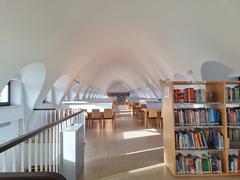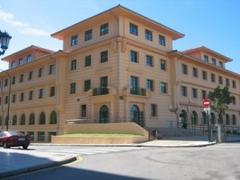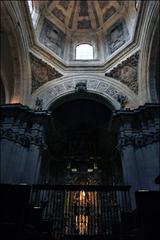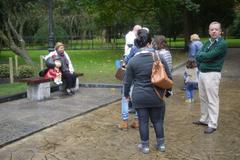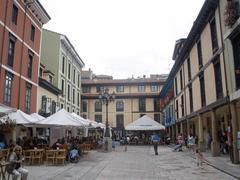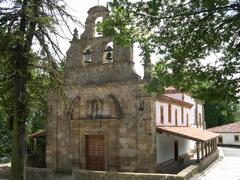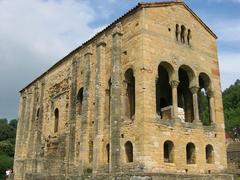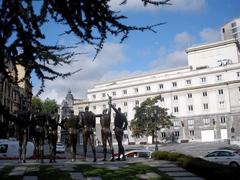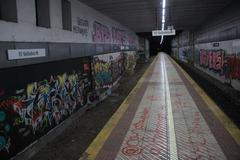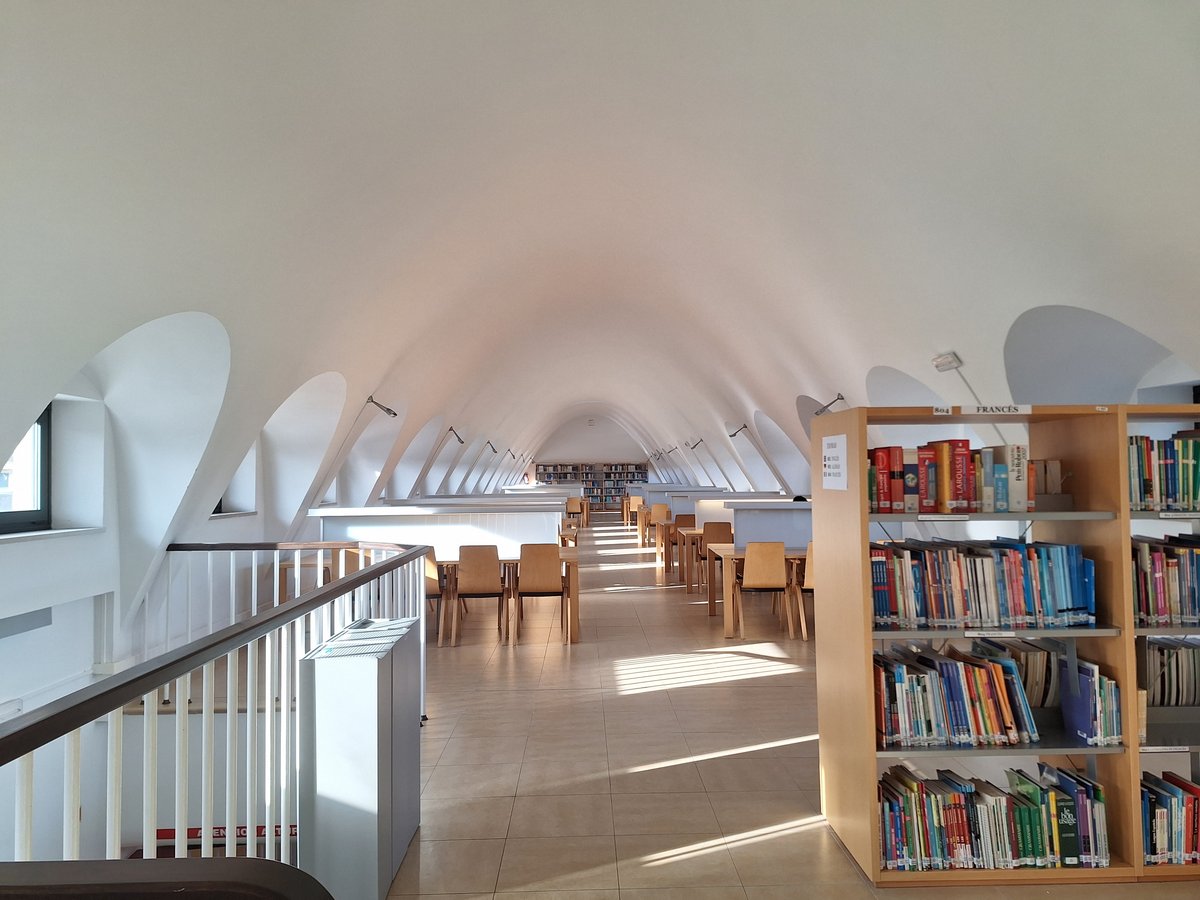
University of Oviedo: Visiting Hours, Tickets, and Historical Sites in Oviedo, Spain
Date: 14/06/2025
Introduction
Situated in the heart of Oviedo, the University of Oviedo stands as a monument to over four centuries of academic excellence and architectural grandeur. Founded in 1608 by Archbishop Fernando de Valdés Salas, it has played a pivotal role in the cultural, intellectual, and urban development of Asturias. The university’s Renaissance and 19th-century buildings—particularly its iconic cloistered courtyard and Clock Tower—offer visitors a vivid connection to Spain’s educational heritage (Spain.info; Wikipedia).
Today, the university is a dynamic academic hub with more than 25,000 students and a rich program of public events. Its location within Oviedo’s UNESCO-listed old town makes it a cultural beacon, drawing visitors interested in history, architecture, and regional identity. This guide provides comprehensive information for planning your visit: from practical details like opening hours and ticketing to cultural highlights and nearby attractions (Times Higher Education; For91Days; Uniovi Official Website; ESN Oviedo).
Table of Contents
- Introduction
- Historical Overview
- Academic and Cultural Significance
- Visiting the University of Oviedo
- Visitor Experience and Practical Tips
- Integration with Oviedo’s Cultural Scene
- Museo de Geología
- Safety and Visitor Services
- Local Events and University Life
- Accommodation and Dining
- FAQ: Common Visitor Questions
- Visuals and Media Suggestions
- Plan Your Visit
Historical Overview
Foundation and Early Years
The University of Oviedo (Universidad de Oviedo) was established in 1608, following the vision and endowment of Archbishop Fernando de Valdés Salas, who sought to bring higher education to Asturias (Wikipedia; ShanghaiRanking). The original campus, designed by Rodrigo Gil de Hontañón and Juan del Ribero Rada, features a classic stone façade and a Renaissance-style cloister.
Expansion and Enlightenment
During the Enlightenment, the university broadened its curriculum to include scientific and secular subjects. In the 19th century, it pioneered the “Extensión Universitaria” movement, democratizing access to culture and education in Spain (ShanghaiRanking).
20th Century Challenges & Recovery
The university endured significant turmoil during the 20th century, suffering damage in the 1934 October Revolution and Spanish Civil War. Restoration and modernization efforts led to the expansion of faculties and the creation of new campuses in Gijón and Mieres (ESN Oviedo).
Architectural and Heritage Value
Declared a Historic-Artistic Monument in 1943, the university’s main building is a masterpiece of Spanish Renaissance architecture. Its central courtyard, chapel, library, and 19th-century Clock Tower are major highlights. The central library houses rare manuscripts and incunabula, contributing to the university’s scholarly legacy (Spain.info).
Modernization and Internationalization
The University of Oviedo has embraced internationalization, sustainable campus development, and digital transformation. The institution was awarded the “Campus of International Excellence” distinction in 2009 and now welcomes over a thousand international students annually (Uniovi).
Academic and Cultural Significance
As the primary university in Asturias, the University of Oviedo has shaped the region’s intellectual and cultural landscape. It offers more than 150 academic programs across 31 faculties, fostering local talent and hosting international collaborations (Times Higher Education). The university’s presence has contributed to Oviedo’s cosmopolitan atmosphere, with students making up about 10% of the city’s population (spainguidenow.com).
Visiting the University of Oviedo
Location & Accessibility
The historic university building is located on Calle San Francisco, at the heart of Oviedo’s pedestrian-friendly old town. The site is easily reachable by foot from major landmarks and transportation hubs and is accessible for visitors with reduced mobility—ramps and elevators are available where needed (audiala.com; en.asturias.com).
Visiting Hours
- Monday to Friday: 9:00 AM – 7:00 PM
- Saturday: 10:00 AM – 2:00 PM
- Sunday & Public Holidays: Closed
Note: Opening times for the central library and exhibitions may vary. Always check the official website before your visit.
Tickets & Guided Tours
- Admission: Access to the main historic building and courtyard is free.
- Guided Tours: Available by reservation through the university or local tourism office; these may require a small fee (typically around €5 for general visitors, free for Oviedo residents and students, with discounts for children, seniors, and groups).
- Booking: Advance booking is recommended, especially in high season (For91Days; Uniovi Official Website).
Highlights and Photographic Spots
- The Renaissance cloistered courtyard
- The 19th-century Clock Tower
- Main façade with Valdés Salas’ coat of arms
- Chapel, Aula Magna, and library interiors
Photography is generally allowed in public areas, but restrictions may apply in sensitive spaces.
Special Events & Exhibitions
The university regularly hosts lectures, art exhibitions, and concerts. The Casa de las Lenguas runs language courses and cultural programs open to the public. Check the events calendar for details.
Nearby Attractions
- Oviedo Cathedral
- Archaeological Museum of Asturias
- Plaza del Fontán
- Campo de San Francisco park
Visitor Experience and Practical Tips
- Plan Ahead: Book guided tours and check event schedules in advance.
- Combine Visits: The university is close to Oviedo’s top landmarks, ideal for a comprehensive cultural day.
- Languages: While Spanish is predominant, English-speaking guides are often available.
- Student Life: Explore surrounding cafés, bookshops, and tapas bars for a taste of university culture.
- Accessibility: Most public areas accommodate mobility needs; inquire ahead for specific routes (audiala.com).
Integration with Oviedo’s Cultural Scene
The University of Oviedo is deeply embedded in the city’s arts, music, and festival life. Its stewardship of public spaces and participation in major events like the San Mateo Festival and White Night further its role as a cultural catalyst (spainguidenow.com; en.asturias.com).
Museo de Geología
Located within the university complex, the Museo de Geología features extensive collections of minerals, fossils, and rocks, with a focus on Asturian geology. Admission is free, and it welcomes visitors of all ages.
Safety and Visitor Services
Oviedo is one of Spain’s safest cities. The university area is well-guarded and tourist-friendly. The El Escorialín Tourist Office provides maps, brochures, and advice. Emergency number: 112.
Local Events and University Life
Major festivals like San Mateo in September and White Night in October often include university-organized activities such as concerts, exhibitions, and lectures. The university also supports Oviedo’s renowned opera season (en.asturias.com).
Accommodation and Dining
Within walking distance of the university, visitors can find a range of hotels, including the historic Hotel de la Reconquista, as well as numerous cafés and restaurants offering Asturian cuisine—fabada, cachopo, and local cider are regional specialties (audiala.com).
FAQ: Common Visitor Questions
Q: What are the university’s visiting hours?
A: Monday to Friday, 9:00 AM–7:00 PM; Saturday, 10:00 AM–2:00 PM; closed Sundays and holidays.
Q: Is there an entrance fee?
A: No, entry to the historic areas is free. Guided tours may have a fee.
Q: How do I book a guided tour?
A: Via the university website or local tourism office; advance booking recommended.
Q: Is the university accessible for disabled visitors?
A: Yes, ramps and elevators are available in most public areas.
Q: Are guided tours available in English?
A: Yes, with prior notice.
Q: Can I visit the Museo de Geología?
A: Yes, admission is free.
Q: Is photography allowed?
A: Photography is permitted in public spaces, but check for restrictions in specific areas.
Visuals and Media Suggestions
- Include high-quality images of the Renaissance courtyard, the Clock Tower, and the library (alt text: “University of Oviedo historic building courtyard,” “University of Oviedo library interior”).
- Add a map showing the university’s location in Oviedo’s old town.
- Explore the university’s virtual tour via the official website.
Plan Your Visit
Experience the University of Oviedo’s rich history and vibrant culture firsthand. For the latest information on hours, tours, and events, consult the official website or the El Escorialín Tourist Office. Enhance your trip with the Audiala app for guided tours and insider tips.
Explore related guides on Oviedo’s historical attractions and Asturias’ cultural heritage to make your visit truly memorable.
References
- Spain.info
- Wikipedia
- Nomads Travel Guide
- GEOviedo City Guide
- Uniovi Official Website
- ESN Oviedo
- Times Higher Education
- For91Days
- Audiala
- ShanghaiRanking
- spainguidenow.com
- en.asturias.com
- wanderlog.com
- goaskalocal.com
